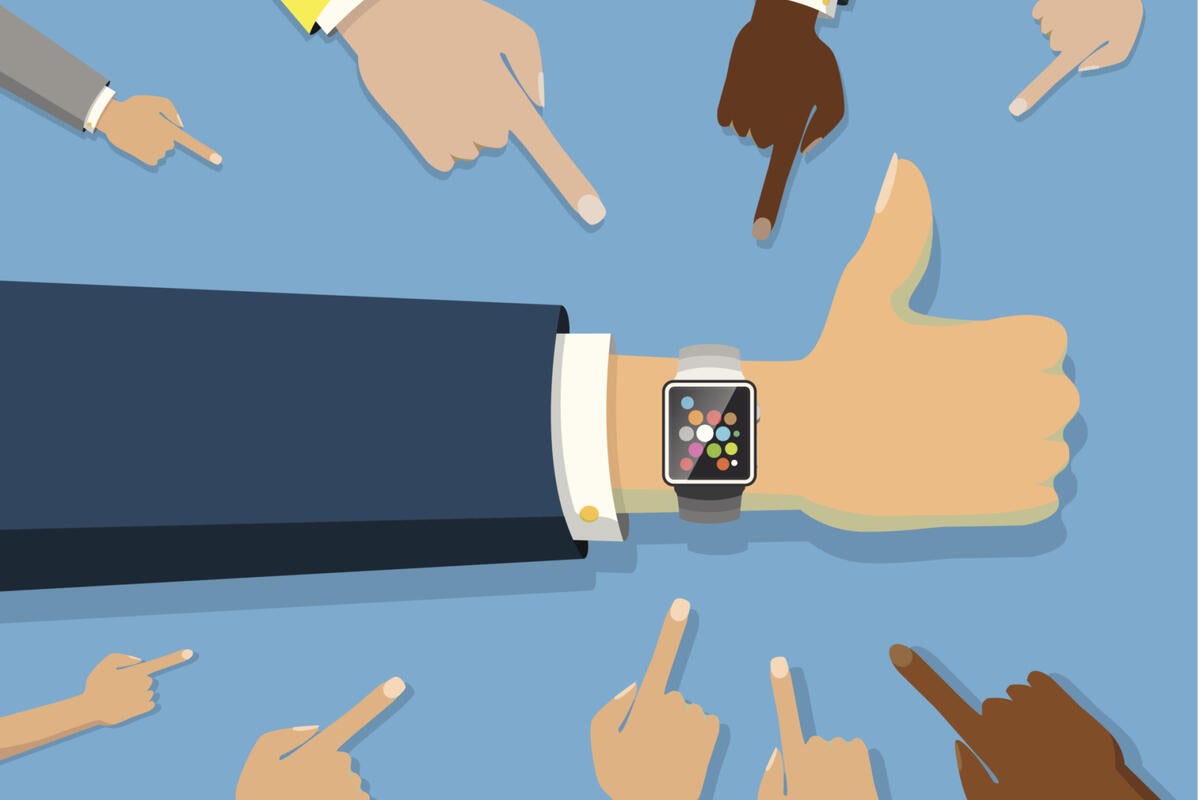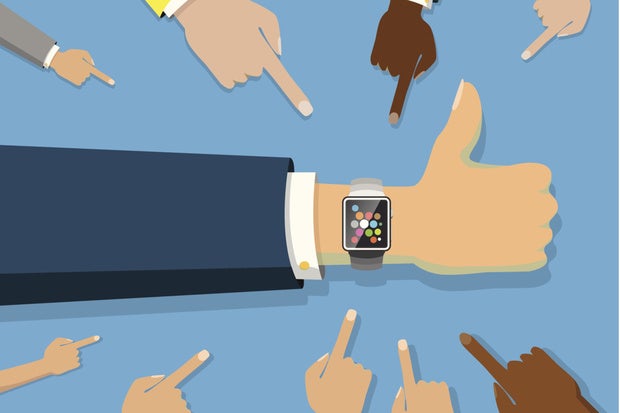
Every wildly successful computing platform gains that success because of a “killer app” — a software category or usage model that compels people to embrace it en masse.
Spreadsheets for the PC. Cameras for the smartphone.
Wearable computing as a generic category has chugged along for years as mere toys for geeks without a killer app that makes everyone want or need one.
While 75 percent of Americans own a PC of some kind and 95 percent own a smartphone, only 20 percent own a wearable device.
But that’s about to change.
Wearable sales and usage are about to skyrocket. And it’s all because of the coronavirus pandemic — and the certainty that future pandemics will occur as well.
Why the world will wear wearables
As a species, humans have a problem. Our “success” as a biological organism has made us our planet’s dominant superspecies. If you’re any other kind of organism, your success depends on surviving human activity or, better still, “using” people to your DNA’s advantage. (Dogs and corn are especially good at using humans to multiply their numbers, for example.)
[ Related: How smartphone apps could save lives (and the economy)]
While not necessarily living organisms, the same goes for viruses. If you really want to succeed as a virus on this planet, you’ll want to get into the human-infection game.
So when the coronavirus, or SARS-CoV-2, made the leap from bats to humans (via some intermediate mammal), it was like 13-year-old Justin Bieber being discovered on YouTube by talent manager Scooter Braun and getting signed to RBMG Records. (For you Generation Zers out there, YouTube was obscure in 2008 and record labels were huge.)
Overpopulation and globalization mean that if anyone in the world gets an extremely contagious virus then everyone can get it.
It takes a couple of years to develop a new vaccine for a new virus. In the interim between outbreak and vaccine, we need to do three things to slow down the outbreak to avoid overwhelming the emergency rooms and causing millions to die from a lack of medical care: 1) monitor outbreaks geographically; 2) maintain social distancing; and 3) quarantine the infected before they’re contagious — and before they’re showing symptoms.
It turns out that wearables — smart watches, rings and glasses — are just what the doctor ordered.
Why wearables are the perfect pandemic prescription
The lowest-hanging fruit in the fight against viral outbreaks is to use the wearable-computing data we already have.
[ Related: 8 tips for managing a remote workforce ]
Smartwatches and fitness trackers already harvest data about the resting heart rate and sleep patterns of millions of users. More-advanced devices measure body temperature. When the human body is fighting infection, the resting heart rate is slightly elevated (easiest to gauge during sleep) and the body temperature rises. Individually, this data could tell you a little. In aggregate, they tell you a lot — specifically, they can offer the earliest possible warning of a flu or coronavirus out in a city, region or country.
The Scripps Research Translational Institute launched a project called DETECT (Digital Engagement & Tracking for Early Control & Treatment), which uses apps to figure out how to detect COVID-19 early. The idea is to use existing smartwatches and activity trackers, such as the Fitbit, to identify the illness from changes in heart rate, activity and sleep patterns. They also hope to be able to early-detect influenza and other illnesses.
The team has demonstrated in the past that by analyzing data from 47,000 Fitbit devices, they could improve predictions of influenza outbreaks at the state level.
The new study goes beyond Fitbit devices to incorporate the Apple Watch, Amazfit or Garmin Watch and others.
The German public health authority this week launched, in partnership with a startup called Thryve, a smartwatch app called Corona-Datenspende. The app harvests pulse, temperature and sleep patterns from smart watches and fitness trackers, which is analyzed and uploaded to produce a public map of viral outbreaks.
It’s also possible that changes in a person’s breathing could reveal COVID-19. A fitness tracker company called Whoop, which makes the Whoop Strap, added COVID-19 as a monitoring option inside their app, which also included the option to participate in a study with Queensland University.
If this study pans out, it could mean that wearables that monitor breathing rate could add another trackable variable for the early detection of viral outbreaks.
Coming together to stay apart — even in the office
Once a local outbreak is detected, it’s important for everyone in the area or country to immediately start practicing social distancing whether they’re infected or not, which means staying at least six feet away from others, even in the workplace. Wearables can help.
A startup called Proxxi, which makes wrist-based devices for electrical industry workers (their main product warns when workers get too close to high-voltage electricity), created a band called Halo that can detect when another band — another worker — is within 6 feet, and will vibrate to notify both users so they can maintain social distancing. The bands also keep a log of who was near whom, so that if anyone get sick the others can be notified for self-quarantine. The band ships May 4.
Meanwhile, all passengers arriving in Hong Kong from abroad are being given mandatory wrist band that enforce a 14-day home quarantine requirement, plus an app called StayHomeSafe. Alerts are sent to the wearers at random, requiring them to use their smartphones to photograph themselves wearing the band, to make sure people don’t take it off and leave it at home while they wander around in Hong Kong.
In addition to maintaining social distancing for everybody as soon as an outbreak occurs, it’s vital to detect exactly who is infected as early as possible and get them into quarantine before they can infect others. COVID-19 makes people contagious several days before they feel symptoms. So to avoid runaway outbreaks, it’s important to quarantine the infected early. But how can you tell who’s been infected? Again, wearables are coming to the rescue.
An Apple Watch app called Cardiogram has recently added the capability to monitor flu or COVID-19 symptoms. The feature looks mainly at resting heart rate and sleep patterns. The app doesn’t diagnose these conditions. It merely shows that something is different, and that you should self-quarantine and consult your doctor.
The Radboud University Medical Center in Nijmegen in the Netherlands is testing whether their experiments to help Parkinson’s disease can be repurposed in the fight against COVID-19. Using smartwatches made by Alphabet’s Verily, researchers are already harvesting data for analysis, including heart rate and skin resistance. Current test participants are now being sent permission documents to enable coronavirus research.
University of California at San Diego and UC San Francisco researchers are working with a smart ring sold by a Finnish company called Oura. The ring takes continuous measurements of the wearer’s temperature, heart rate, respiration rate and activity, which scientists believe may help detect or track COVID-19. The ring offloads data via Bluetooth to a purpose-built smartphone app. Ideally, the ring should detect COVID-19 before symptoms begin. Tens of thousands of volunteers are currently testing the ring, including at least 2,000 frontline healthcare workers (it also monitors stress and anxiety).
Wearables that tell people they could be infected are great. But what about people who don’t have wearables?
A Chinese AI startup called Rokid sells smart glasses that can detect and record infrared images and temperatures of anyone up to a distance of three meters, as well as send an alert when someone with a fever is recorded. They also do face recognition. The glasses are already deployed in China. And the company is reportedly talking with “several companies” in the United States to use them here.
This is an example of a wearable that could detect possible infection in people who do not have their own infection-detecting wearable. And there are others.
Enterprise smart glasses maker Vuzix is partnering with a company called Librestream, which makes a thermal camera called the Onsight Cube, to combine the glasses with the camera to detect COVID-19. Using purpose-built software, the glasses-camera combination can display real-time thermal video as augmented reality. The idea is that first responders can take temperatures and detect fever by simply looking at people, and also record that information.
ThirdEye Gen’s X2 MR Glasses are also being dragooned into service in the fight against COVID-19. As paramedics help someone, video and audio are beamed to doctors in the hospital, and the person’s temperature is taken in real-time without contact via a built-in thermal sensor. This can help the spread of a virus to the first responders and also hospital staff.
In addition to quarantining people with detectable symptoms that could mean infection, it’s also a good idea to quarantine everyone who came in contact with the infected. That’s the purpose of the Apple/Google partnership I told you about last week. But this outcome can also be effected at the company level.
Estimote, which is a company founded to create Bluetooth beacons, has created a line of wearables to fight COVID-19. Called Proof of Health, the wristbands offer contact tracing. The device uses passive GPS location and also Bluetooth and UWB proximity monitoring. The data is uploaded so that management can see how employees are doing with social distancing, and so that anyone who came in contact with people who test positive can self-quarantine.
What pandemics mean for wearables
The Great Coronavirus Pandemic of 2020 is traumatizing everyone, and is causing massive social and economic disruption. It’s the great Black Swan event of our lifetimes and will continue to disrupt everything for at least two years.
Meanwhile, scientists, governments and private companies are proving that wearable devices are our most effective tools for detecting outbreaks, enforcing social distancing and identifying for quarantine those infected well before symptoms occur.
Once the technologies and practices for using wearables to fight outbreaks is developed, it will be trivial to simply build these into existing wearable platforms.
Protecting yourself, your family, your co-workers, your company, your country and your species from the next catastrophic viral outbreak (not to mention the annual flu) is the application that will make wearables desirable, popular and necessary.
That’s right. It turns out that wearables’ killer app is saving humanity from killer viruses.



